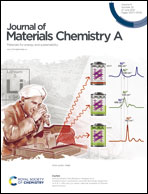Supramolecular Co-adsorption on TiO2 to enhance the efficiency of dye-sensitized solar cells†
Abstract
Three novel push–pull dyes, with carbazole donors, coded AJ502, TZ101 and TZ102 are synthesized and applied as co-sensitizers in dye-sensitized solar cells (DSSCs). TZ101 and TZ102 have similar structures except for two fluorine atoms introduced on the benzotriazole (BTZ) unit. AJ502 shows a near-IR absorption spectrum that is suitable for co-sensitization with TZ101 and TZ102. The co-sensitized DSSC device based on CO-1 (AJ502 : TZ101 = 3 : 4 (0.075 mM : 0.1 mM)) achieves a power conversion efficiency (PCE) of 10.3% under AM 1.5G irradiation, with 1.06 V open-circuit voltage (Voc), 13.75 mA cm−2 short-circuit photocurrent density (Jsc), and 70.8% fill factor (FF), a significant improvement compared to the single dye, 6.0% for AJ502 and 5.1% for TZ101 with a copper(I/II)-based redox electrolyte. A PCE of 8.9% is also obtained by devices based on CO-2 (AJ502 : TZ102 = 3 : 4). For CO-1, the fluorine atoms in TZ101 play a critical role by widening the active light capturing bands of both TZ101 and AJ502 on the TiO2 film while TZ102 and AJ502 show weaker interaction under the same conditions. The UV-vis spectrum and Raman spectrum revealed that AJ502 can form supramolecules with TZ101 and TZ102 formed on the TiO2 film.



 Please wait while we load your content...
Please wait while we load your content...